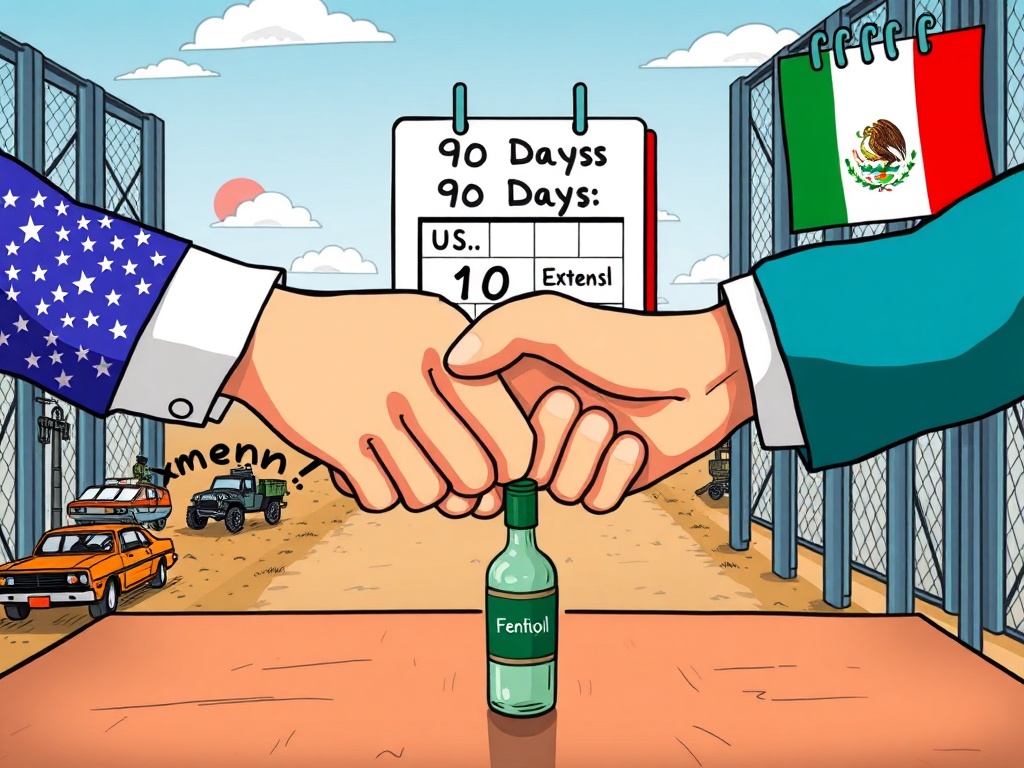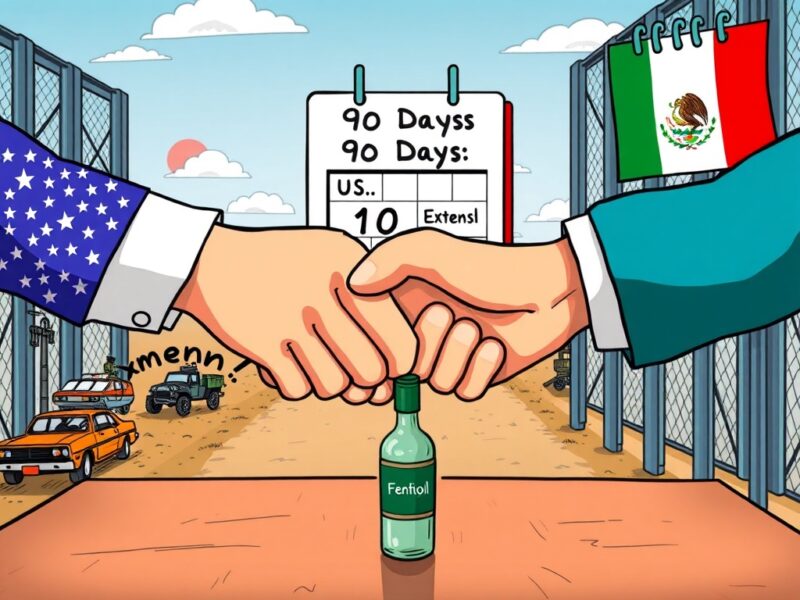BitcoinWorld

Unveiling the Crucial 90-Day Extension of the US Mexico Trade Deal
In a significant development for North American commerce, recent reports indicate that the United States has extended its crucial US Mexico Trade Deal for an additional 90 days. This move, announced by former President Trump, signals a continued, albeit temporary, framework for one of the world’s most dynamic bilateral trade relationships. For businesses, consumers, and policymakers alike, understanding the nuances of this extension and its implications is paramount, especially as global economic landscapes continue to shift. What does this mean for the flow of goods, the future of manufacturing, and the fight against illicit trade?
What Does the Extended US Mexico Trade Deal Entail?
The 90-day extension of the US Mexico Trade Deal maintains specific tariff structures and introduces new agreements on trade barriers. At its core, this extension ensures that certain goods crossing the border will continue to face duties, while also pushing for a more streamlined trade environment by addressing non-tariff obstacles. This complex arrangement reflects ongoing negotiations and strategic economic priorities.
Here’s a breakdown of the key elements:
- Continued Tariffs: Mexico will proceed with a 25% tariff on specific categories, including fentanyl and cars. Additionally, a higher 50% tariff will remain in place for vital industrial materials such as steel, aluminum, and copper. These tariffs are not merely revenue generators; they are tools intended to influence trade flows and domestic production.
- Removal of Non-Tariff Trade Barriers: A significant part of the agreement is Mexico’s commitment to immediately remove its non-tariff trade barriers. These are often less visible than tariffs but can be equally, if not more, disruptive to trade. They include regulations, quotas, subsidies, and other measures that make it difficult or costly for foreign goods to enter a market.
This extension, while seemingly short-term, provides a window for further dialogue and potentially a more permanent resolution to some of the long-standing trade disagreements between the two nations. It underscores the intricate balance between protecting domestic industries and fostering a robust cross-border supply chain.
Why is the US Mexico Trade Deal Extension So Significant?
The relationship between the United States and Mexico is one of deep economic interdependence. The US Mexico Trade Deal, previously embodied by NAFTA and now by the USMCA (United States-Mexico-Canada Agreement), underpins billions of dollars in trade annually, affecting everything from automotive production to agricultural markets. The decision to extend this deal, even for a limited period, carries immense significance for several reasons:
- Economic Stability: A stable trade environment is crucial for businesses on both sides of the border. Uncertainty can deter investment, disrupt supply chains, and ultimately harm economic growth. This extension provides a degree of predictability, allowing industries to plan for the immediate future without drastic changes.
- Supply Chain Resilience: North American supply chains are highly integrated, particularly in sectors like automotive. Components often cross the border multiple times during the manufacturing process. The continuation of the trade deal, even with existing tariffs, prevents a sudden collapse of these established networks, which would have severe repercussions for production costs and consumer prices.
- Political Signaling: The extension also serves as a political signal of ongoing engagement and a willingness to negotiate. Despite past disagreements and the imposition of tariffs, both nations recognize the mutual benefits of maintaining a functional trade relationship.
- Addressing Key Issues: By extending the deal, there’s an implicit agreement to continue working on contentious issues, such as the flow of illicit substances like fentanyl, and balancing trade deficits in key industries.
Without this extension, businesses would face a much more uncertain future, potentially leading to significant economic disruption and a reevaluation of manufacturing and sourcing strategies across North America.
The Impact on Key Sectors: Cars, Steel, and Fentanyl within the US Mexico Trade Deal
The specific tariffs outlined in the extended US Mexico Trade Deal directly target sectors that are vital to both economies. Understanding their impact requires a closer look at each industry:
Automotive Industry: Driving Through Tariffs
The 25% tariff on cars imported from Mexico has been a contentious point. Mexico is a major hub for automotive manufacturing, with many global automakers having significant operations there. These tariffs aim to incentivize car production within the U.S. or shift supply chains. However, they can also increase costs for consumers and reduce competitiveness for companies that rely on cross-border manufacturing. The extension means that companies will continue to factor these costs into their pricing and production strategies, rather than facing a sudden change that could force immediate restructuring.
Steel, Aluminum, and Copper: Foundations of Industry
The 50% tariff on steel, aluminum, and copper from Mexico is particularly impactful for manufacturing, construction, and infrastructure development. These raw materials are fundamental to countless industries. The high tariff rate is designed to protect domestic U.S. producers of these metals. While this might support U.S. jobs in these sectors, it can also lead to higher input costs for U.S. manufacturers who rely on Mexican imports, potentially making their final products more expensive or less competitive globally. The continuation of these tariffs maintains a specific market dynamic for these essential commodities.
Fentanyl: A Public Health and Trade Challenge
The inclusion of fentanyl in trade discussions highlights the intersection of public health crises and economic policy. The 25% tariff on fentanyl, an opioid, is an unconventional use of trade policy. It signals a strong intent to combat the flow of this dangerous substance, which has caused a severe public health crisis in the United States. While tariffs are primarily economic tools, their application here underscores a broader strategy to use all available levers to address critical national issues. The extension means this pressure point on the drug trade through economic means will persist.
Addressing Non-Tariff Barriers: A New Frontier in the US Mexico Trade Deal?
While tariffs are direct and quantifiable, non-tariff trade barriers (NTBs) are often more insidious and complex. Mexico’s agreement to immediately remove its non-tariff trade barriers as part of the extended US Mexico Trade Deal is a significant development. NTBs can include:
- Quotas: Limits on the quantity of goods that can be imported.
- Import Licenses: Bureaucratic requirements that can delay or prevent imports.
- Customs Procedures: Overly complex or slow customs processes.
- Technical Barriers to Trade (TBTs): Regulations, standards, testing, and certification procedures that disproportionately affect imported goods.
- Sanitary and Phytosanitary (SPS) Measures: Health and safety standards for agricultural products that can be used to restrict trade.
- Subsidies: Government support for domestic industries that makes foreign goods less competitive.
The removal of these barriers aims to streamline trade, reduce administrative burdens, and lower the cost of doing business across the border. For U.S. exporters, this could mean faster market access, reduced compliance costs, and increased competitiveness in the Mexican market. It represents a move towards greater trade facilitation, which benefits businesses by making cross-border transactions smoother and more predictable.
What Are the Potential Challenges and Opportunities for the US Mexico Trade Deal?
The 90-day extension of the US Mexico Trade Deal presents both challenges and opportunities for stakeholders on both sides of the border.
Challenges:
- Uncertainty Remains: A 90-day extension is still a short-term solution. Businesses require long-term certainty for significant investments and strategic planning. The looming question of what happens after this period can still create hesitation.
- Tariff Burden: While continued, the tariffs on key goods like cars, steel, aluminum, copper, and fentanyl remain a cost burden for importers and potentially consumers. They can distort market prices and reduce the overall efficiency of integrated supply chains.
- Enforcement of NTB Removal: While Mexico has agreed to remove non-tariff barriers, the actual implementation and enforcement of this commitment will be crucial. Monitoring and ensuring compliance can be complex and require ongoing dialogue.
Opportunities:
- Dialogue and Negotiation Window: The extension provides valuable time for both nations to engage in further negotiations, address outstanding issues, and potentially forge a more comprehensive and stable long-term agreement.
- Supply Chain Optimization: With the current framework maintained, businesses can continue to optimize their existing North American supply chains without the immediate threat of drastic disruption, focusing on efficiency within the current tariff structure.
- Increased Trade Facilitation: The commitment to remove non-tariff barriers, if effectively implemented, could lead to genuinely smoother and more cost-effective trade, benefiting a wide range of industries that export to Mexico.
- Addressing Fentanyl Flow: The explicit inclusion of fentanyl in the trade discussion offers an ongoing opportunity to use economic leverage to combat the illicit drug trade, potentially leading to more effective joint strategies.
Ultimately, the success of this extension will hinge on the willingness of both governments to engage constructively and find common ground on issues that are vital to their respective national interests and economic prosperity.
Conclusion: Navigating the Future of the US Mexico Trade Deal
The 90-day extension of the US Mexico Trade Deal is a pivotal moment, reflecting the complex and interconnected nature of modern international trade. While it offers a temporary reprieve from uncertainty and allows for continued dialogue, it also highlights the ongoing challenges of balancing national interests with the benefits of global commerce. The continuation of specific tariffs, coupled with the critical commitment to remove non-tariff barriers, sets the stage for what could be a period of intense negotiation and strategic realignment. For businesses and policymakers, remaining agile and informed will be key to navigating this evolving landscape and harnessing the opportunities that arise from this crucial bilateral relationship. The future of North American trade hinges on these delicate balances, promising continued developments that will shape the economic trajectory of the region.
Frequently Asked Questions (FAQs)
Q1: What exactly is the US Mexico Trade Deal being extended?
A1: The extension refers to the ongoing trade framework between the United States and Mexico, which largely operates under the United States-Mexico-Canada Agreement (USMCA), the successor to NAFTA. This 90-day extension continues specific tariff rates and agreements on non-tariff barriers.
Q2: Which products are specifically affected by the tariffs in this extension?
A2: Under the extended agreement, Mexico will continue to pay a 25% tariff on fentanyl and cars. Additionally, a 50% tariff remains in place for steel, aluminum, and copper imports from Mexico.
Q3: What are non-tariff trade barriers, and why is their removal significant?
A3: Non-tariff trade barriers are restrictions on trade that are not tariffs, such as quotas, import licenses, complex customs procedures, and technical standards. Their immediate removal is significant because they can be just as restrictive as tariffs, making trade more costly and time-consuming. Their removal aims to streamline cross-border commerce.
Q4: How does this extension impact the automotive industry?
A4: The 25% tariff on cars from Mexico continues to impact the automotive industry by increasing costs for manufacturers and potentially consumers. However, the extension provides stability, preventing immediate drastic shifts in supply chains that could occur if the deal were to lapse without a clear alternative.
Q5: Is this extension a permanent solution to trade issues between the US and Mexico?
A5: No, the 90-day extension is a temporary measure. It provides a window for continued negotiations and dialogue between the two nations, aiming to address outstanding trade issues and potentially work towards a more stable, long-term agreement beyond this period.
Q6: How does the tariff on fentanyl fit into a trade deal?
A6: The tariff on fentanyl is an unconventional but significant aspect of the trade deal, highlighting the intersection of trade policy and public health concerns. It reflects an attempt to use economic leverage to combat the flow of illicit substances and address the opioid crisis in the United States.
If you found this article insightful, please consider sharing it with your network! Your support helps us continue to provide timely and comprehensive analysis of global economic developments. Share on social media:
To learn more about the latest economic policy trends, explore our article on key developments shaping global trade institutional adoption.
This post Unveiling the Crucial 90-Day Extension of the US Mexico Trade Deal first appeared on BitcoinWorld and is written by Editorial Team





